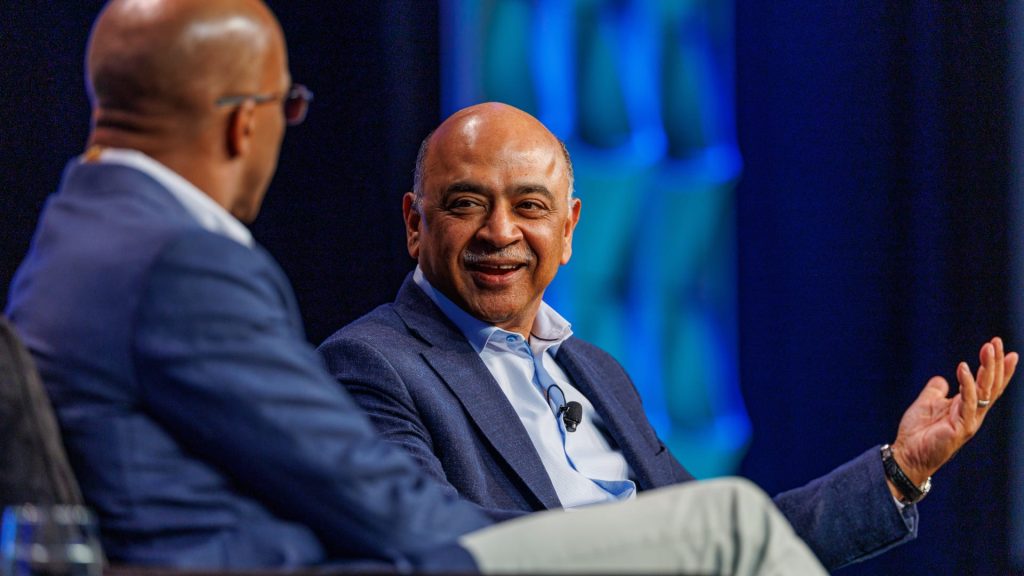IBM has reported better-than-expected earnings and revenue for the first quarter of the year, highlighting the company’s resilience amidst a challenging economic climate. The technology giant reported earnings per share of $1.60, exceeding analysts’ expectations, while revenue reached $14.54 billion, surpassing consensus forecasts. Despite a slight decline in net income, company officials expressed optimism about future revenue growth, particularly in hybrid cloud and artificial intelligence sectors.
| Article Subheadings |
|---|
| 1) Overview of IBM’s Quarterly Performance |
| 2) Key Financial Metrics and Future Projections |
| 3) Breakdown of Revenue Sources |
| 4) Strategic Acquisitions and Legal Proceedings |
| 5) Economic Challenges and Market Response |
Overview of IBM’s Quarterly Performance
On Wednesday, IBM announced its financial results for the first quarter, showcasing a positive trajectory despite a complicated marketplace. The company achieved an earnings per share (EPS) of $1.60, which is notably higher than the anticipated $1.40. Revenue for the quarter was reported at $14.54 billion, exceeding the expected figure of $14.4 billion. This results in a modest year-over-year increase of 0.6%, from $14.5 billion in the first quarter of the previous year. However, the net income for the quarter saw a decline, dropping to $1.06 billion or $1.12 per share, compared to $1.61 billion or $1.72 per share during the same period last year. This reflects IBM’s ongoing efforts to enhance productivity under the leadership of Jim Kavanaugh, the company’s chief financial officer, who highlighted these strategies during a conference call with analysts.
Key Financial Metrics and Future Projections
Looking ahead, IBM has set ambitious targets for the next financial year. The company reiterated its expectation of achieving $13.5 billion in free cash flow for 2025, along with at least a 5% increase in revenue at constant currency rates. Current market analyses suggest that currency exchange rates will deliver a 150 basis points boost to growth expectations for 2025, a reduction from the previously forecasted 200 basis points in January. IBM’s management anticipates the second-quarter revenue to fall between $16.4 billion and $16.75 billion. The midpoint of this range, at $16.58 billion, exceeds the consensus forecast of $16.33 billion provided by LSEG analysts. This cautious but optimistic outlook conveys IBM’s commitment to maintaining its marketplace foothold and leveraging growth avenues in technology.
Breakdown of Revenue Sources
The company’s revenue streams saw varied performances across its divisions in the first quarter. The software division reported a strong growth of 7%, fetching in $6.34 billion, in line with analyst expectations. Specifically, the hybrid cloud software category, which encompasses Red Hat, displayed a growth rate of 12%, albeit a decline from the impressive 16% growth recorded in the fourth quarter of the previous fiscal year. However, the consulting division faced a slight downturn, generating $5.07 billion in revenue, a 2% decrease compared to prior periods. This split showcases the divergent performance across IBM’s offerings, raising questions about the market’s ongoing demand for certain technology solutions.
Strategic Acquisitions and Legal Proceedings
In addition to revealing its quarterly earnings, IBM also announced pivotal developments in its corporate strategy. The company has settled its ongoing lawsuits with chip manufacturer GlobalFoundries, reflecting a stabilizing pivot in its operational landscape. Moreover, IBM has closed its acquisition of cloud software maker HashiCorp for $6.4 billion, enhancing its cloud capabilities. Future growth initiatives also include plans to acquire data storage software startup DataStax, although financial terms for this transaction remain undisclosed. These strategic moves indicate IBM’s proactive approach to bolstering its offerings to meet client demands and enhance its competitive edge in the rapidly evolving tech ecosystem.
Economic Challenges and Market Response
Despite its strong earnings, IBM’s leadership acknowledged the broader economic climate’s impact on future performance. CEO Arvind Krishna noted the emerging trends of hesitancy among clients, underscoring the need for businesses to prioritize financial sustainability in uncertain times. Kavanaugh further elaborated that under current economic conditions, some clients have adopted a ‘wait-and-see’ approach before committing to substantial expenditures. This cautious behavior can be attributed to pressures related to potential tariffs and economic policies being discussed at the federal level, which may influence market dynamics and spending choices across various sectors. Additionally, delays or cancellations of government contracts, noted by the U.S. Department of Governmental Efficiency, could pose further challenges for IBM’s consulting unit.
| No. | Key Points |
|---|---|
| 1 | IBM reported a better-than-expected EPS of $1.60 against the predicted $1.40. |
| 2 | Revenue for Q1 stood at $14.54 billion, exceeding the $14.4 billion forecast. |
| 3 | The company anticipates a revenue range of $16.4 to $16.75 billion for the second quarter. |
| 4 | IBM has completed key acquisitions, including HashiCorp, to enhance cloud capabilities. |
| 5 | Economic uncertainties are prompting clients to pause on significant spending decisions. |
Summary
IBM’s first-quarter performance underscores the company’s strategic focus on hybrid cloud and AI while navigating a complex economic landscape. With strong earnings and planned acquisitions, the company showcases resilience and adaptability. However, it also faces headwinds as clients remain cautious in their spending, reflecting broader economic uncertainties. Looking forward, IBM’s approach to address these challenges will play a pivotal role in maintaining its market position and achieving its growth objectives.
Frequently Asked Questions
Question: What factors influenced IBM’s first-quarter performance?
IBM’s performance was driven by strong software revenues and strategic acquisitions, although net income faced a decline. Economic uncertainties and client hesitance have influenced spending decisions.
Question: How has IBM addressed its legal challenges?
IBM has successfully settled its lawsuits with chip manufacturer GlobalFoundries, alleviating some legal pressures from its operational landscape.
Question: What are IBM’s future growth expectations?
IBM anticipates a free cash flow of $13.5 billion by 2025, with plans for at least 5% revenue growth, despite fluctuating currency rates impacting forecasts.
